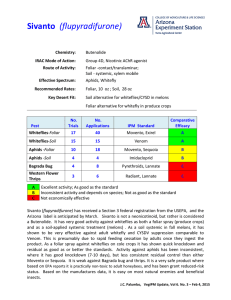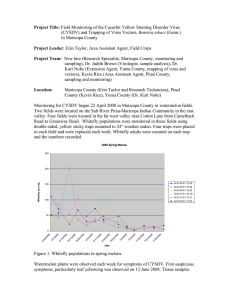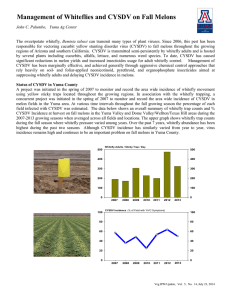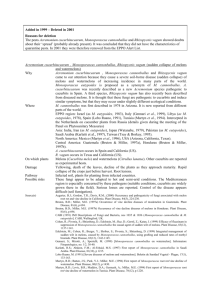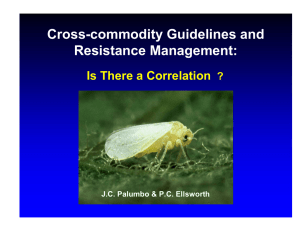2015 Guidelines For Whitefly / CYSDV Management on Melons
advertisement
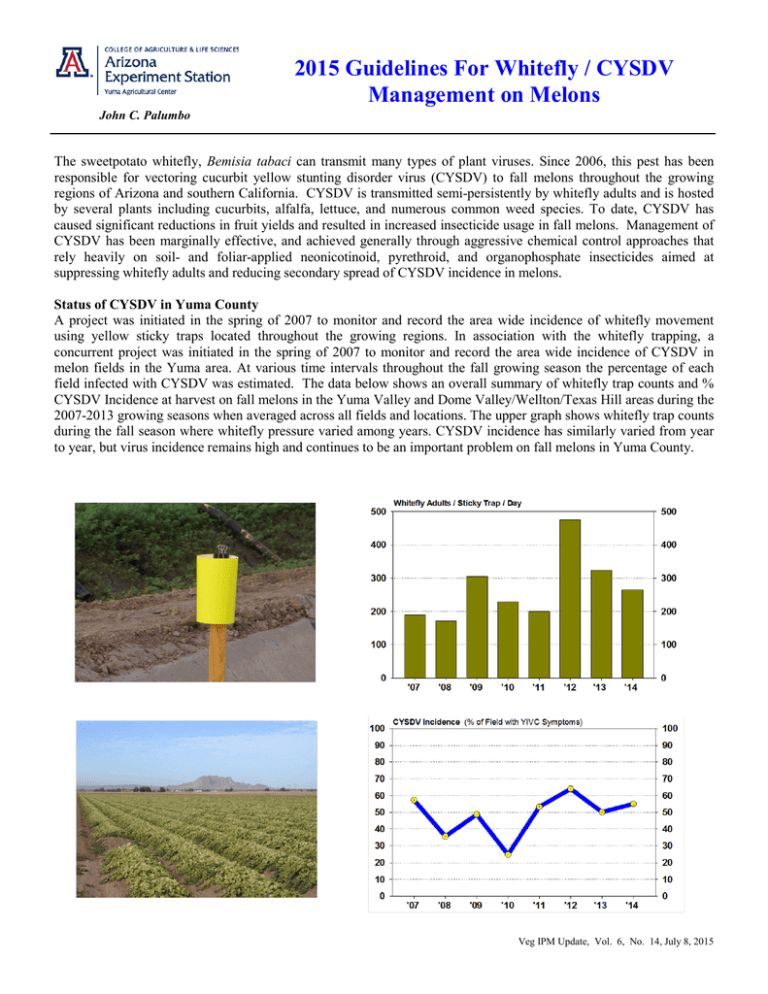
2015 Guidelines For Whitefly / CYSDV Management on Melons John C. Palumbo The sweetpotato whitefly, Bemisia tabaci can transmit many types of plant viruses. Since 2006, this pest has been responsible for vectoring cucurbit yellow stunting disorder virus (CYSDV) to fall melons throughout the growing regions of Arizona and southern California. CYSDV is transmitted semi-persistently by whitefly adults and is hosted by several plants including cucurbits, alfalfa, lettuce, and numerous common weed species. To date, CYSDV has caused significant reductions in fruit yields and resulted in increased insecticide usage in fall melons. Management of CYSDV has been marginally effective, and achieved generally through aggressive chemical control approaches that rely heavily on soil- and foliar-applied neonicotinoid, pyrethroid, and organophosphate insecticides aimed at suppressing whitefly adults and reducing secondary spread of CYSDV incidence in melons. Status of CYSDV in Yuma County A project was initiated in the spring of 2007 to monitor and record the area wide incidence of whitefly movement using yellow sticky traps located throughout the growing regions. In association with the whitefly trapping, a concurrent project was initiated in the spring of 2007 to monitor and record the area wide incidence of CYSDV in melon fields in the Yuma area. At various time intervals throughout the fall growing season the percentage of each field infected with CYSDV was estimated. The data below shows an overall summary of whitefly trap counts and % CYSDV Incidence at harvest on fall melons in the Yuma Valley and Dome Valley/Wellton/Texas Hill areas during the 2007-2013 growing seasons when averaged across all fields and locations. The upper graph shows whitefly trap counts during the fall season where whitefly pressure varied among years. CYSDV incidence has similarly varied from year to year, but virus incidence remains high and continues to be an important problem on fall melons in Yuma County. Veg IPM Update, Vol. 6, No. 14, July 8, 2015 2009 2010 2011 2012 2013 2014 CYSDV(%) 75 -100 % 51 – 74 % 26 - 50 % 0 – 25 % Veg IPM Update, Vol. 6, No. 14, July 8, 2015 Area wide maps of the Dome Valley-Wellton-Texas Hill areas where fall melons were produced from 2009-2014 are shown above. Estimates of virus show that CYSDV incidence in 2009 was greatest in the center of the region near Wellton. Most of these melons fields had > 75% virus (red triangles). These same areas also had the highest whitefly abundance as indicated by sticky traps. Several of the fields were grown near spring melon watermelons fields. On either end of the valley, CYSDV was much lower and suggests that isolation from host crops may play a key role in minimizing virus incidence on fall melons. The melons on the eastern end (right side) of the valley where CYSDV incidence was ~5-10% were produced under fabric row covers. In contrast, CYSDV incidence on fall melons in 2010 was considerably lower, even though the whitefly numbers were higher than 2009 numbers, and alfalfa was grown adjacent to many of the fields. This was particularly evident in the center region near Wellton. The Texas Hill area (far right) had the very overall lowest incidence of both whiteflies and CYSDV even though less than half of this acreage was grown under row covers. CYSDV incidence was highest in the Dome Valley area. A similar trend was observed in 2011 where fields in the Wellton area had very high infection rates while fields planted further east had much lower incidence of CYSDV. In 2012, the fall melons were concentrated from Ave. 33E to Ave. 47 E. As anticipated, the virus incidence was very high near Wellton, but was also higher in some of the fields grown further east; many at higher rates than seen in previous years. Not surprising, spring melons were scattered throughout the region the previous spring. By the 2013 season, growers were seeking more isolation by planting in the eastern-most regions of the area where CYSDV incidence has traditionally been lighter. However, even in these isolated areas moderate levels of CYSDV was present in 2013. In 2014, two of the 3 blocks of melons on the eastern most part of the region had levels of CYSDV > 50%. Not surprising, in areas where CYSDV incidence was the highest, had been grown within 0.5-1 mile the previous spring. Our observations and research suggests that placement of these melons away from areas of known spring melons production provides the least risk of infection. Cultural Management / Avoidance One important key to managing CYSDV and avoiding economic losses in fall melons is to effectively prevent whitefly populations from migrating from infected alternative hosts (i.e., spring melons) onto subsequent plantings of susceptible fall melons. In 2007 and 2008, local growers attempted to do this through the creation of a 25 day “melonfree” period during July and August. Unfortunately, this approach was not successful in suppressing CYSDV in fall melons due largely to the preponderance of volunteer melons throughout the regions, as well as the discovery that hosts plants such as alfalfa and common weeds (pigweed, common mallow, groundcherry and siverleaf nightshade) can serve as a reservoir for CYSDV. However, several cultural tactics can be employed when practical to minimize the host-availability for both CYSDV and whiteflies during the summer. • Sanitation Prompt removal of CYSDV host plants and weeds in area where fall melons will be grown can reduce then availability of virus. This includes rapid destruction of plant residue following harvest which not only serves as a reservoir of CYSDV, but for whiteflies too. Also the destruction of volunteer melons between spring and fall crops can reduce the source of virus inoculum available. This can be done by disking or applying a contact, burn-down herbicide to fields. Volunteer plants should be destroyed as soon as practical. Recent research has indicated that fall melons grown near spring melons with volunteers (<1.8 miles) are at a higher risk of CYSDV infection. • Row Covers Lightweight fabric row covers have been successfully deployed in both experimental plots and commercial fields to delay incidence of virus. Covers must be present on the seed bed prior to the plant emergence to prevent adult whiteflies from feeding on seedlings and transmitting CYSDV. Covers must be removed prior to blooming to ensure adequate pollination of the crop. Use of a soil insecticide at planting/sidedress and foliar sprays immediately following removal are recommended following removal. • Crop Placement / Isolation Whenever possible, fall melons should be planted as far away from previously grown spring melons. As noted above, fall melons are at a high risk of CYSDV when plated in proximity to spring melons. Also, when practical, fall melons should be planted as far away from cotton, alfalfa and other host crops that serve as a reservoir for whiteflies. Recent research has indicated that fall melons grown within 1 mile of cotton can be at a higher risk of CYSDV infection. This is due to cotton being a potential source of large whitefly populations, as well harboring infected weeds and volunteer melons. Also consider avoiding planting near residential subdivisions and orchards, both of which may contain sources of infected cucurbits and weed hosts. Veg IPM Update, Vol. 6, No. 14, July 8, 2015 Chemical Management The goal of insecticide management programs are aimed at the adult whitefly vector. Suppression of migrating whitefly adults should minimize primary infection in newly emerging stands, whereas aggressive management during early crop growth (up to bloom stage) will aid in suppressing the secondary spread of CYSDV once the stand is established. Because CYSDV is a semi-persistent virus, quick acting systemic and contact insecticides can reduce the incidence of CYSDV by suppressing adult whitefly feeding and consequently their ability to effectively transmit the virus. Research has shown that the longer whitefly feeding (transmission of CYSDV) is delayed on young melon plants, the less severe the virus is expressed (leaf yellowing and interveinal chlorosis) at harvest. The local standard approach to achieving this has been to prevent adult whiteflies from feeding on emerging melons plants as long as possible (from emergence to bloom) through the use of soil and foliar applied insecticides. The proper applications and timing of insecticides is important to cost-effective management of the vector and virus. Based on local research, we have developed guidelines for a 3-stage approach for the use of insecticides on fall melons in the desert southwest. I. At Planting Product Venom 70WG Rate/ac 6 oz Scorpion 35SL 10.5 oz Sivanto 240SL 28 oz Use patterns Furrow: apply at planting, 3-4 inches directly below seedline in 10-20 gpa of water; Drip: chemigate at or just prior to seedling emergence; II. Emergence to 1st Bloom (Prior to honey bees placed in field) Product Rate/ac Use patterns Venom 70WG 6 oz Scorpion 35SL 10.5 oz Furrow: apply with fertilizer at 1 side-dress. Do not apply Venom or Scorpion as foliar sprays following soil applications. Drip: chemigate 7-14 d following emergence. Lannate SP 0.75 lb Vydate L 3 pts Dimethoate 1.5 pts Sequoia 4.5 oz Exirel 0.83OL Assail 30SG 16-20 oz Apply as foliar sprays to plants at 2 leaf stage or older. Can expect 5-7 day residual. Reapply at 4-6 day 5.3 oz Sequoia 4.5 oz st Apply as foliar sprays Most effective on 1-2 leaf stage plants. Can expect ~3-5 day knockdown residual depending on WF immigation. Tank-mixture with a pyrethroid may improve knockdown. intervals when whitefly migrations are heavy. III. Bloom to Netted Fruit Product Assail 30SG Exirel 0.83OL Fulfill 50WG Rate/ac Use patterns 5.3 oz Apply as foliar sprays to blooming plants at night when 16-20 oz bees are not active. Reapply as necessary to control adults. Tank-mixture with a pyrethroid if possible. 2.75 oz Oberon 2SC Vetica 8.5 oz 17 oz Knack 0.86EC 10 oz Apply as foliar sprays to control immature whiteflies Will not provide control of adults or suppression of CYSDV transmission Veg IPM Update, Vol. 6, No. 14, July 8, 2015
